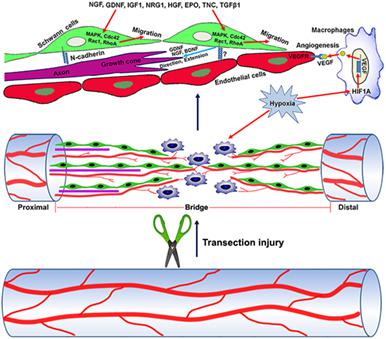Our official English website, www.x-mol.net, welcomes your
feedback! (Note: you will need to create a separate account there.)
Migrating Schwann cells direct axon regeneration within the peripheral nerve bridge.
Glia ( IF 5.4 ) Pub Date : 2020-07-22 , DOI: 10.1002/glia.23892 Qing Min 1 , David B Parkinson 2 , Xin-Peng Dun 1, 2, 3
Glia ( IF 5.4 ) Pub Date : 2020-07-22 , DOI: 10.1002/glia.23892 Qing Min 1 , David B Parkinson 2 , Xin-Peng Dun 1, 2, 3
Affiliation

|
Schwann cells within the peripheral nervous system possess a remarkable regenerative potential. Current research shows that peripheral nerve‐associated Schwann cells possess the capacity to promote repair of multiple tissues including peripheral nerve gap bridging, skin wound healing, digit tip repair as well as tooth regeneration. One of the key features of the specialized repair Schwann cells is that they become highly motile. They not only migrate into the area of damaged tissue and become a key component of regenerating tissue but also secrete signaling molecules to attract macrophages, support neuronal survival, promote axonal regrowth, activate local mesenchymal stem cells, and interact with other cell types. Currently, the importance of migratory Schwann cells in tissue regeneration is most evident in the case of a peripheral nerve transection injury. Following nerve transection, Schwann cells from both proximal and distal nerve stumps migrate into the nerve bridge and form Schwann cell cords to guide axon regeneration. The formation of Schwann cell cords in the nerve bridge is key to successful peripheral nerve repair following transection injury. In this review, we first examine nerve bridge formation and the behavior of Schwann cell migration in the nerve bridge, and then discuss how migrating Schwann cells direct regenerating axons into the distal nerve. We also review the current understanding of signals that could activate Schwann cell migration and signals that Schwann cells utilize to direct axon regeneration. Understanding the molecular mechanism of Schwann cell migration could potentially offer new therapeutic strategies for peripheral nerve repair.
中文翻译:

迁移的雪旺细胞指导周围神经桥内的轴突再生。
周围神经系统内的雪旺细胞具有显着的再生潜力。目前的研究表明,周围神经相关的雪旺氏细胞具有促进多种组织修复的能力,包括周围神经间隙桥接、皮肤伤口愈合、指尖修复以及牙齿再生。专门修复雪旺氏细胞的关键特征之一是它们变得高度运动。它们不仅迁移到受损组织区域并成为再生组织的关键组成部分,而且还分泌信号分子以吸引巨噬细胞、支持神经元存活、促进轴突再生、激活局部间充质干细胞并与其他细胞类型相互作用。目前,在周围神经横断损伤的情况下,迁移雪旺细胞在组织再生中的重要性最为明显。神经横断后,来自近端和远端神经残端的雪旺细胞迁移到神经桥中并形成雪旺细胞索以引导轴突再生。神经桥中雪旺细胞索的形成是横断损伤后成功修复周围神经的关键。在这篇综述中,我们首先研究了神经桥的形成和神经桥中雪旺细胞迁移的行为,然后讨论了迁移的雪旺细胞如何引导再生轴突进入远端神经。我们还回顾了目前对可以激活雪旺细胞迁移的信号和雪旺细胞用于指导轴突再生的信号的理解。
更新日期:2020-07-22
中文翻译:

迁移的雪旺细胞指导周围神经桥内的轴突再生。
周围神经系统内的雪旺细胞具有显着的再生潜力。目前的研究表明,周围神经相关的雪旺氏细胞具有促进多种组织修复的能力,包括周围神经间隙桥接、皮肤伤口愈合、指尖修复以及牙齿再生。专门修复雪旺氏细胞的关键特征之一是它们变得高度运动。它们不仅迁移到受损组织区域并成为再生组织的关键组成部分,而且还分泌信号分子以吸引巨噬细胞、支持神经元存活、促进轴突再生、激活局部间充质干细胞并与其他细胞类型相互作用。目前,在周围神经横断损伤的情况下,迁移雪旺细胞在组织再生中的重要性最为明显。神经横断后,来自近端和远端神经残端的雪旺细胞迁移到神经桥中并形成雪旺细胞索以引导轴突再生。神经桥中雪旺细胞索的形成是横断损伤后成功修复周围神经的关键。在这篇综述中,我们首先研究了神经桥的形成和神经桥中雪旺细胞迁移的行为,然后讨论了迁移的雪旺细胞如何引导再生轴突进入远端神经。我们还回顾了目前对可以激活雪旺细胞迁移的信号和雪旺细胞用于指导轴突再生的信号的理解。











































 京公网安备 11010802027423号
京公网安备 11010802027423号